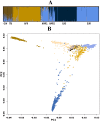Genetic diversity of 'Very Important Pharmacogenes' in two South-Asian populations
- PMID: 34824904
- PMCID: PMC8590392
- DOI: 10.7717/peerj.12294
Genetic diversity of 'Very Important Pharmacogenes' in two South-Asian populations
Abstract
Objectives: Reliable identification of population-specific variants is important for building the single nucleotide polymorphism (SNP) profile. In this study, genomic variation using allele frequency differences of pharmacologically important genes for Gujarati Indians in Houston (GIH) and Indian Telugu in the U.K. (ITU) from the 1000 Genomes Project vis-à-vis global population data was studied to understand its role in drug response.
Methods: Joint genotyping approach was used to derive variants of GIH and ITU independently. SNPs of both these populations with significant allele frequency variation (minor allele frequency ≥ 0.05) with super-populations from the 1000 Genomes Project and gnomAD based on Chi-square distribution with p-value of ≤ 0.05 and Bonferroni's multiple adjustment tests were identified. Population stratification and fixation index analysis was carried out to understand genetic differentiation. Functional annotation of variants was carried out using SnpEff, VEP and CADD score.
Results: Population stratification of VIP genes revealed four clusters viz., single cluster of GIH and ITU, one cluster each of East Asian, European, African populations and Admixed American was found to be admixed. A total of 13 SNPs belonging to ten pharmacogenes were identified to have significant allele frequency variation in both GIH and ITU populations as compared to one or more super-populations. These SNPs belong to VKORC1 (rs17708472, rs2359612, rs8050894) involved in Vitamin K cycle, cytochrome P450 isoforms CYP2C9 (rs1057910), CYP2B6 (rs3211371), CYP2A2 (rs4646425) and CYP2A4 (rs4646440); ATP-binding cassette (ABC) transporter ABCB1 (rs12720067), DPYD1 (rs12119882, rs56160474) involved in pyrimidine metabolism, methyltransferase COMT (rs9332377) and transcriptional factor NR1I2 (rs6785049). SNPs rs1544410 (VDR), rs2725264 (ABCG2), rs5215 and rs5219 (KCNJ11) share high fixation index (≥ 0.5) with either EAS/AFR populations. Missense variants rs1057910 (CYP2C9), rs1801028 (DRD2) and rs1138272 (GSTP1), rs116855232 (NUDT15); intronic variants rs1131341 (NQO1) and rs115349832 (DPYD) are identified to be 'deleterious'.
Conclusions: Analysis of SNPs pertaining to pharmacogenes in GIH and ITU populations using population structure, fixation index and allele frequency variation provides a premise for understanding the role of genetic diversity in drug response in Asian Indians.
Keywords: 1000 Genomes Project; Allele frequency; GIH; ITU; Pharmacogenes; SNPs; Variant calling; gnomAD.
©2021 Bharti et al.
Conflict of interest statement
The authors declare there are no competing interests.
Figures








Similar articles
-
Estimation of genetic variation in vitiligo associated genes: Population genomics perspective.BMC Genom Data. 2024 Jul 26;25(1):72. doi: 10.1186/s12863-024-01254-6. BMC Genom Data. 2024. PMID: 39060965 Free PMC article.
-
Identifying signatures of positive selection in pigmentation genes in two South Asian populations.Am J Hum Biol. 2017 Sep 10;29(5). doi: 10.1002/ajhb.23012. Epub 2017 Apr 24. Am J Hum Biol. 2017. PMID: 28439965
-
Assessing the Occurrence and Influence of Cancer Chemotherapy-Related Pharmacogenetic Alleles in the Chilean Population.Pharmaceutics. 2024 Apr 19;16(4):561. doi: 10.3390/pharmaceutics16040561. Pharmaceutics. 2024. PMID: 38675222 Free PMC article.
-
Genetic Analysis of Pharmacogenomic VIP Variants of ABCB1, VDR and TPMT Genes in an Ethnically Isolated Population from the North Caucasus Living in Jordan.Curr Drug Metab. 2020;21(4):307-317. doi: 10.2174/1389200221666200505081139. Curr Drug Metab. 2020. PMID: 32368972
-
The global spectrum of protein-coding pharmacogenomic diversity.Pharmacogenomics J. 2018 Jan;18(1):187-195. doi: 10.1038/tpj.2016.77. Epub 2016 Oct 25. Pharmacogenomics J. 2018. PMID: 27779249 Free PMC article.
Cited by
-
Bray-Curtis (AFD) differentiation in molecular ecology: Forecasting, an adjustment ( A A), and comparative performance in selection detection.Ecol Evol. 2022 Sep 11;12(9):e9176. doi: 10.1002/ece3.9176. eCollection 2022 Sep. Ecol Evol. 2022. PMID: 36110882 Free PMC article.
-
Estimation of genetic variation in vitiligo associated genes: Population genomics perspective.BMC Genom Data. 2024 Jul 26;25(1):72. doi: 10.1186/s12863-024-01254-6. BMC Genom Data. 2024. PMID: 39060965 Free PMC article.
-
Symptom improvement in a South Asian patient with Parkinson's disease treated with immediate- and extended-release carbidopa-levodopa: a case report.J Med Case Rep. 2025 Jul 7;19(1):321. doi: 10.1186/s13256-025-05385-x. J Med Case Rep. 2025. PMID: 40624690 Free PMC article.
-
Pharmacogenomic variation in the Malagasy population: implications for the antimalarial drug primaquine metabolism.Pharmacogenomics. 2023 Jul;24(11):583-597. doi: 10.2217/pgs-2023-0091. Epub 2023 Aug 8. Pharmacogenomics. 2023. PMID: 37551613 Free PMC article.
References
-
- Allegra S, Cusato J, De Francia S, Longo F, Pirro E, Massano D, Avataneo V, De Nicolò A, Piga A, D’Avolio A. The effect of vitamin D pathway genes and deferasirox pharmacogenetics on liver iron in thalassaemia major patients. Pharmacogenomics Journal. 2019;19(5):417–427. doi: 10.1038/s41397-019-0071-7. - DOI - PubMed
LinkOut - more resources
Full Text Sources
Research Materials
Miscellaneous

